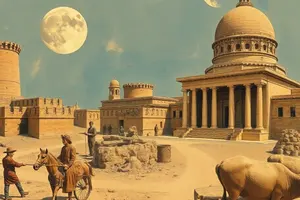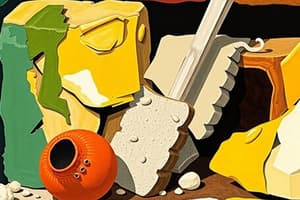Podcast
Questions and Answers
How do archaeologists utilize material culture to understand past societies?
How do archaeologists utilize material culture to understand past societies?
- By translating ancient literary works to uncover societal norms.
- By examining physical artifacts, resources, and spaces left by early humans. (correct)
- By analyzing the genetic information extracted from ancient bones.
- By directly interviewing descendants of ancient civilizations.
What is the primary method used by archaeologists to categorize artifacts when constructing a historical narrative?
What is the primary method used by archaeologists to categorize artifacts when constructing a historical narrative?
- Grouping artifacts into different 'periods' and 'cultures' based on shared characteristics. (correct)
- Arranging artifacts chronologically based on carbon dating alone.
- Distributing artifacts geographically without considering cultural context.
- Classifying artifacts by their monetary value on the current market.
The Stone Age, Bronze Age, and Iron Age are defined by what criteria?
The Stone Age, Bronze Age, and Iron Age are defined by what criteria?
- The religious beliefs held by the people of each time period.
- The artistic styles prevalent in each era.
- The predominant materials used for making artifacts. (correct)
- The types of structures built during the time period.
Initially, what purpose did terms such as Paleolithic and Neolithic serve in archaeological studies?
Initially, what purpose did terms such as Paleolithic and Neolithic serve in archaeological studies?
How have the traditional definitions of periods like the Paleolithic and Neolithic evolved over time?
How have the traditional definitions of periods like the Paleolithic and Neolithic evolved over time?
Which of the following best describes ‘material culture’?
Which of the following best describes ‘material culture’?
If archaeologists discover a site with a prevalence of iron tools along with distinct burial practices, what conclusions might they draw?
If archaeologists discover a site with a prevalence of iron tools along with distinct burial practices, what conclusions might they draw?
Why is understanding material culture important for constructing historical narratives?
Why is understanding material culture important for constructing historical narratives?
How do archaeologists use material culture to learn about past civilizations?
How do archaeologists use material culture to learn about past civilizations?
An archaeologist discovers a settlement with a mix of stone tools and early bronze items. What might they infer about this civilization?
An archaeologist discovers a settlement with a mix of stone tools and early bronze items. What might they infer about this civilization?
Flashcards
Material Culture
Material Culture
Physical objects, resources, and spaces people use to define their culture.
Archaeological Organization
Archaeological Organization
Grouping artifacts into periods to understand and narrate history.
Stone, Bronze, and Iron Ages
Stone, Bronze, and Iron Ages
Historical periods named after the primary materials used for tools and artifacts.
Paleolithic
Paleolithic
Signup and view all the flashcards
Neolithic
Neolithic
Signup and view all the flashcards
Study Notes
Material Culture
- Material culture involves the physical artifacts, resources, and spaces used by people to define their culture.
- Archaeologists study material remains left by early humans to understand the socio-economic conditions of the past.
- Artifacts are grouped into different periods and cultures to organize findings and construct a historical narrative.
Historical Periods
- The Stone Age, Bronze Age, and Iron Age were identified based on the primary materials used for making artifacts.
- Terms like Paleolithic (Old Stone Age) and Neolithic (New Stone Age) initially defined periods, later representing cultures from prehistoric times.
Studying That Suits You
Use AI to generate personalized quizzes and flashcards to suit your learning preferences.




